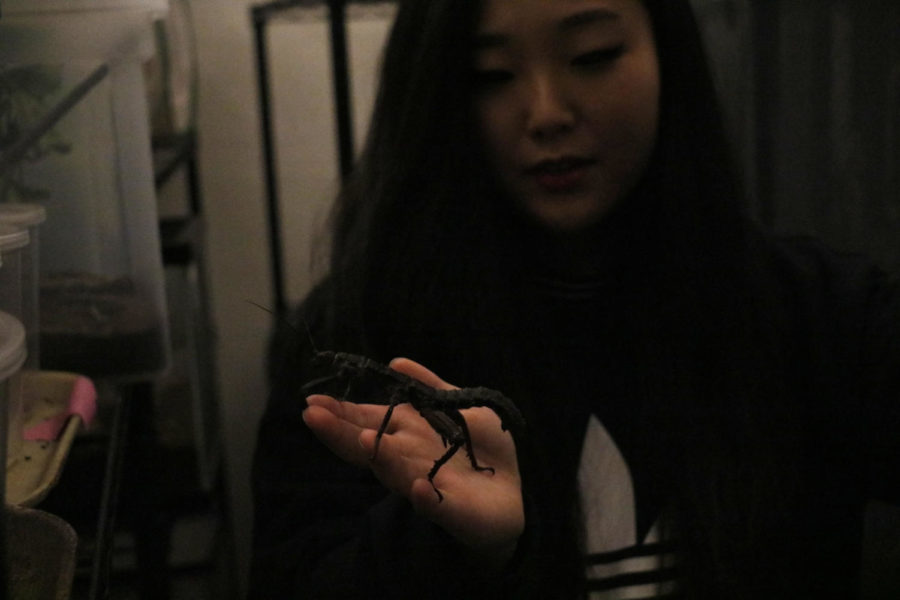It’s a bug’s life: Iowa State’s Insect Zoo
January 12, 2018
Food. Sex. Survival.
Those are the three things everyone, including insects, want in life, said Jillian Kurovski, Insect Zoo employee.
This comparison is just one way Kurovksi helps the public relate to insects. She finds that when you get people to relate to the them, the more willing they are to learn.
This aspect of educating the public on insects and their importance is the main mission of Iowa State’s Insect Zoo.
“It was really created as an outreach for kids, which we still are today, just to grow an awareness of the animals and hopefully to foster some sort of appreciation for the animals at the same time,” said Ginny Mitchell, educational program coordinator of the zoo.
Although they know that not everyone is going to think their animals are cute and cuddly like they do, they do ask that people respect their role in the environment, Kurovksi said.
The employees and interns travel all around the state of Iowa to present displays and host interactive programs. They are able to educate all ages on the importance of insects in the environment. Over the past five and a half years, the zoo has been to 89 of the 99 counties in the state.
“That’s a lot to do in part with our relationship with the outreach offices in each individual county,” Mitchell said.
They host displays at large events such as county fairs and family nights. At these events they bring up to 100 species of arthropods and interact with the public in a come-and-go setting.
“We have babies who will pet tarantulas to people who are 90 years old who think it is just the absolute most amazing thing they’ve ever seen,” Kurovski said.
In addition to their larger displays, the zoo has a variety of school group, small group and family options.
Their most popular option is what they call their interactive program. It’s geared toward school aged children from kindergarten through 12th grade. It’s a one hour program and it’s all hands on, Mitchell said.
Within that program they teach children about metamorphosis, defense mechanisms and mimicry within insects. They also handle the animals and allow the kids to touch them, starting out small with mealworms and working their way up to tarantulas.
“It’s incredible because not only do you get to show people these cool things they’ve never seen before, but you definitely change the stigma around insects and arachnids which is awesome,” said Emily Gamble, another employee of the zoo.
The Insect Zoo does charge for tours. It is nine dollars per person for up to seven people in a group. These tours last for a minimum of an hour and can last at different lengths based on the interests of the individuals. To set up a tour, people can go their website and fill out a request form.
Ran through the department of entomology, the Insect Zoo has been around for 20 years. It resides on the fourth floor of Science Hall II. It was created in 1997 by Dr. Gregory Courtney. Dr. Courtney is still a member of the faculty today and is also the curator of Iowa State’s Insect Museum.
Today, there are five employees and six interns. Out of the five paid employees, all five are women.
Kurovski, junior in animal ecology, started working at the zoo as a freshman. Her favorite thing about working at the zoo is being able to inspire young kids, especially girls, about learning about insects.
“Most people associate bugs to be a masculine thing,” Kurovski said.
Kurovski is also head of the rearing room. The rearing room is one of two rooms the zoo has. The rearing room keeps the insects who need higher humidity and heat. Breeding takes place in this room as well.
The second is the arachnid room where they keep a variety of animals such as scorpions, tarantulas and centipedes.
Currently the zoo has around 70 to 75 species, including their tarantulas and scorpions. Within those species, they have some very well known animals like hissing cockroaches and black widow spiders.
“Once you work here long enough, you cannot connect with the public on their fear level, there’s no way you can understand it,” Kurvoski laughed.
With taking care of the animals on a daily basis, even over breaks, the employees spend a lot of time feeding and taking care of the hundreds of insects within the zoo.
“Honestly there couldn’t be a better job, when I get to go to work, I get to interact with all these incredible animals that I’ve never seen before,” Gamble said.
Whether it is taking care of all the animals everyday, displaying them at events or helping kids interact with them, the members of the Insect Zoo really care about their jobs.
“We love each of these animals so much,” Kurovski said. “Its not even funny how much we really love them.”







